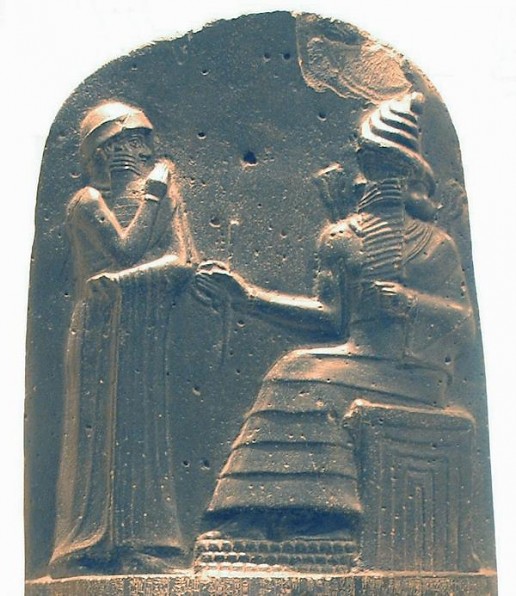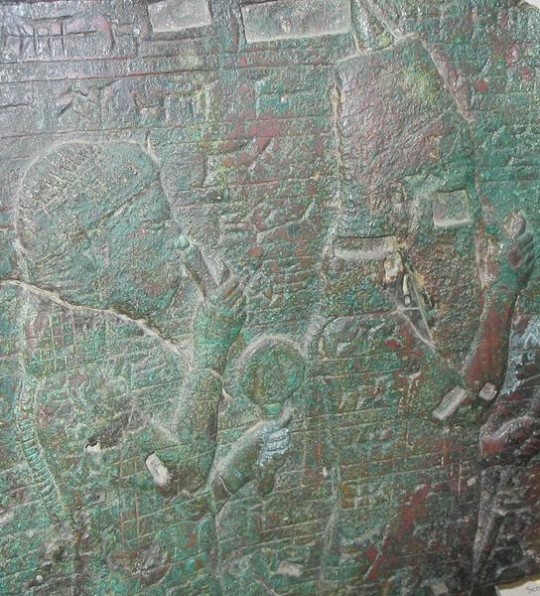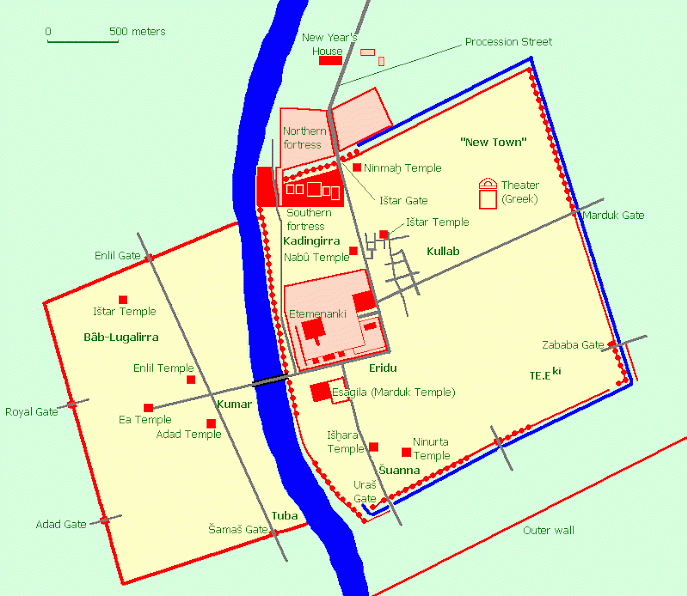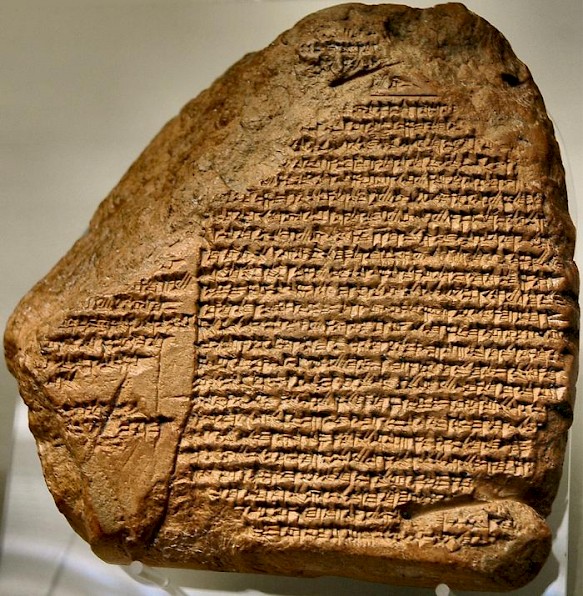Babylonian Empire
Q47690The Babylonian Empire was the most powerful state in the ancient world after the fall of the Assyrian empire (612 BCE). Its capital Babylon was beautifully adorned by king Nebuchadnezzar, who erected several famous buildings. Even after the Babylonian Empire had been overthrown by the Persian king Cyrus the Great (539), the city itself remained an important cultural center.
Old Babylonian Period

The city of Babylon makes its first appearance in our sources after the fall of the Empire of the Third Dynasty of Ur, which had ruled the city states of the alluvial plain between the rivers Euphrates and Tigris for more than a century (2112-2004?). An agricultural crisis meant the end of this centralized state, and several more or less nomadic tribes settled in southern Mesopotamia. One of these was the nation of the Amorites ("westerners"), which took over Isin, Larsa, and Babylon. Their kings are known as the First Dynasty of Babylon (1894-1595?).
The area was reunited by Hammurabi, a king of Babylon of Amorite descent (1792-1750?). From his reign on, the alluvial plain of southern Iraq was called, with a deliberate archaism, Mât Akkadî, "the country of Akkad", after the city that had united the region centuries before. We call it Babylonia. It is one of the most fertile and rich parts of the ancient world.
First, Babylon and its ally Larsa fought a defensive war against Elam, the archenemy of Akkad. After this war had been brought to a successful end, Hammurabi turned against Larsa, and defeated its king Rim-Sin. This scenario was repeated. Together with king Zimrilim of Mari, Hammurabi waged war against Aššur, and after success had been achieved, the Babylonians attacked their ally. Mari was sacked. Other wars were fought against Jamšad (Aleppo), Elam, Ešnunna, and the mountain tribes in the Zagros. Babylon now was the capital of the entire region between Harran in the northwest and the Persian Gulf in the southeast.
Hammurabi's successes became the problems of his successors. After the annexation of Mari in the northwest and Ešnunna in the east, there was no buffer against the increasing power of the Hittite Empire (in Anatolia) and the Kassite tribes in the Zagros. It was impossible for the successors of Hammurabi to fight against all these enemies at the same time, and they started to loose grip. In the deep south, we find independent rulers (the Sea Land Dynasty). The enemies sometimes invaded Babylonia, and in 1595 (?), the Hittite king Mursilis I advanced along the Euphrates, sacked Babylon, and even took away the statue of the supreme god of Babylonia, Marduk, from its temple, the Esagila.
Kassite Period
After this spectacular raid, the Kassite tribes took over the city, but they were soon babylonized. The first king of the Kassite dynasty, Agum-Kakrîme, is reported to have defeated the Hittites and received back the statue of Marduk. Even if this is just propaganda, it proves that the Kassites understood the Babylonians. Yet, a decline started that was to last for almost a millennium. This does not mean that there was no central state, or that the Kassite kings played no role in international politics, but it is clear that Babylon was eclipsed by other nations.
The first to do so was the kingdom of Mitanni, which dominated the northern part of Mesopotamia, and got into trouble when the Hittites and Assyrians united forces against the Mitannians. After the decline of Mitanni, the Middle-Assyrian Empire became powerful, and in the thirteenth century, the Babylonian rulers had to respect the claims of Assyrian kings like Shalmaneser and Tikulti-Ninurta. The latter captured Babylon and took away the image of Marduk, but the occupation of Babylonia and the exile of the god did not last long. Another local power was Elam. In the twelfth century, its armies looted Babylon. Now it was their turn to capture the statue. (And a lot of other things: the famous stela with the laws of king Hammurabi was excavated in the Elamite capital Susa.)
Middle Babylonian Period
The Kassite kings were replaced as rulers of southern Mesopotamia by the Second Dynasty of Isin. Under Nebuchadnezzar I (1126-1104), the Babylonians advanced to Elam, and received back the statue of Marduk. However, this revival was brief. In the eleventh century, Aramaeans infiltrated Babylonia, and the central government disappeared for some time. The cities were independent again. There are few sources, which suggests that the country was unable to pay for scribes. This is not unlike the situation in Assyria, which suffered from decline after the reign of Tiglath-Pileser I (1114-1076), or the more western parts of the ancient world, where the centuries between 1100 and 800 are often called "the dark ages".
What is certain, however, is that southwest of Babylonia, a new group of people settled, the Chaldaeans, who were related to the Aramaeans. The relations between the Babylonians, who had already assimilated the Amorites and Kassites, and the new intruders were at first hostile, but the Chaldaeans increasingly babylonized.
Assyrian Period
The Assyrians were the first to recover from the recession. Under king Aššurnasirpal II (883-859), their empire started to grow again, and this expansion continued during the reigns of his successors. One of the great challenges was the integration of Babylonia, which was Assyria's twin-culture and too highly esteemed to be reduced to the status of province. Tiglath-pileser III (744-727) sought a solution in a "double monarchy": he united the two countries in a personal union.

Soon, new measures had to be taken. Twice, the Babylonians claimed their independence under king Marduk-apla-iddin (721-710 and 703; the Biblical Merodach Baladan). The second revolt was punished harshly by the Assyrian leader Sennacherib, who sacked the city and deported its inhabitants to Nineveh. This new policy was soon regretted. Sennacherib's successor Esarhaddon allowed the people to return. Yet, the relation between Assyria and the Babylonians remained tense. Aššurbanipal (668-631) thought he solved the problem by making his brother Šamaš-šuma-ukin viceroy of the southern part of Mesopotamia, but this turned out to be the wrong idea too: while the king of Assyria was involved in other wars, the Babylonian king revolted, and it took Aššurbanipal several years before he had restored order (648; ABC 15). It has been assumed that the man who is called the successor of Šamaš-šuma-ukin, Kandalanu, is in fact the same as the Assyrian king, although it is certain that the viceroy was still alive in 627, whereas no documents of Aššurbanipal are known after 631.
Neo-Babylonian Period
However this may be, after the death of Aššurbanipal, there were serious troubles in Assyria. In 627, the Assyrian king sent two of his relatives, Sin-šumlišir and Sin-šar-iškun, as governors of Babylon. They were expelled by a Babylonian soldier named Nabopolassar, who had once fought in the Assyrian army but now started a kingdom for himself. According to the Babylonian chronicle known as ABC 2, he was recognized as king on 23 November 626. This is the beginning of the Neo-Babylonian Empire.
Nabopolassar continued the struggle against Assyria, which he wante to overthrow. If he succeeded, the balance of power in the Near East would be seriously endangered; consequently, the Egyptians supported the Assyrians against the aggressors.
The Fall of Nineveh Chronicle describes the events of these years. In 616, Nabopolassar defeated an Assyrian force on the banks of the Euphrates, south of Harran. This suggests that Nabopolassar wanted to block the main road between the Assyrian heartland and its possessions in the west. However, he was forced to retreat when an Egyptian army approached.
Next year, the Babylonian changed his strategy and invaded the Assyrian heartland, where he laid siege to Aššur, the religious capital of Assyria. The Assyrians were able to repel their enemy, but late in 615, the Medes, a tribal federation living in modern Iran, intervened. After the winter, they captured the city, and although Nabopolassar arrived too late to help them, he signed a treaty with their king Cyaxares. The Babylonian historian Berossus tells that the alliance was cemented by a royal wedding: the Babylonian crown prince Nebuchadnezzar married a princess named Amytis.
After a year of inconclusive campaigning, the united Medes and Babylonians laid siege to the Assyrian capital Nineveh in May 612. The siege lasted for three months; in July, the city fell. King Sin-šar-iškun, who had once been in charge of Babylon (above), seems to have committed suicide.
Several campaigns took place in the neighborhood of Harran, from which the last Assyrian king, Aššur-uballit, was expelled. Yet he returned with the army of the pharaoh of Egypt, Necho II (610-595). (King Josiah of Judah, who had tried to conquer the former kingdom of Israel, which had become part of the Assyrian Empire, tried to resist the Egyptians, but was killed at Megiddo.) Necho was defeated too, in 605, by crown prince Nebuchadnezzar, near Karchemish on the banks of the Euphrates. The story is told in the Nebuchadnezzar Chronicle.
In the same year, Nabopolassar, the founding father of the Babylonian Empire, died. His son continued the expansion to the west, where he took over the former Assyrian possessions. It is not entirely clear where and when the border between Egypt and Babylonia was drawn: 2 Kings 24.7 implies that Egypt retired to the Sinai desert and left the Palestine coast in Babylonian hands, but the Greek researcher Herodotus of Halicarnassus suggests that Gaza remained an Egyptian stronghold.note
During this phase of the western war, Jerusalem was captured (597), and when its vassal king revolted, the city was captured for the second time (587). Its population was deported to Babylonia: the beginning of the Babylonian Captivity of the Jews. Now, the west was safe; only Tyre resisted, and although the siege lasted many years, it fell in 585.

It is possible that the "Labynetos" mentioned by Herodotus as the man who, together with the Cilician leader Syennesis, arranged a peace treaty between the Lydian king Alyattes and the Median king Cyaxares in 585, is identical to Nebuchadnezzar. This is far from certain, but its likely that the Babylonians, who had now conquered the west, were interested in Anatolia, where iron was to be obtained. At the same time, Nebuchadnezzar seems to have had more or less friendly relations with the mountain tribes in the east.
What had happened, in fact, was that the great monarchy of the ancient Near East had received a new elite: the Assyrians had been replaced by the Babylonians, but the empire itself remained more or less the same. Likewise, the later Achaemenid and Seleucid empires were not really different from earlier empires. The ancient history of the Near East is one of change and continuity.
Later history
Nebuchadnezzar died in 562 and was succeeded in by his son Amel-Marduk, who was almost immediately murdered and replaced by his brother-in-law Neriglissar (559-556), who invaded Anatolia, was victorious in Cilicia, and even crossed the Taurus. But in spite of his success, he was replaced by a new king, Nabonidus, who obtained power by a coup d'état.

The reason may have been that Neriglissar was a commoner - rich, certainly, but without royal blood. It is possible that the man behind the coup was the king's son Bêlsharusur or Belshazzar. However this may be, Nabonidus was not taken seriously - ancient sources like the Verse Account of Nabonidus call him a madman and a blasphemer, who preferred the cult of Sin in Harran above that of Marduk. This is confirmed by the Nabonidus Chronicle, which informs us about the king's neglect of the Akitu festival.
Yet, Nabonidus was able to add large parts of Arabia to the Empire, especially the part later called Nabataea. Why he subdued them is unclear, but it is possible that he was looking for an alliance against the Persians, an Iranian nation related to the Medes. In 550, their leader Cyrus the Great had overthrown the last king of Media, Astyages, and in c.547, he had added Lydia to his possessions - king Croesus was executed. After this campaign, we find no references to Cilician iorn in our Babylonian sources, which suggests that Cilicia had sided with Cyrus. In Babylon, people must have seen that something terrible was advancing from the east and north. In 539, Cyrus attacked, and captured the city. His son Cambyses was made viceroy.
This was the end - and yet, it was not the end. The Babylonians remembered that they had once been rulers of the world and revolted several times. The names of several of their leaders have been recorded: Nidintu-Bêl or Nebuchadnezzar III (522), Arakha or Nebuchadnezzar IV (521), Bêl-šimânni and Šamaš-eriba (both 484), and Nidin-Bêl (336/335). It is likely that there were more rebels.